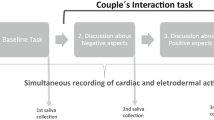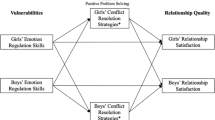Abstract
The present research builds upon the extant literature as it assesses psychophysiological factors in relation to empathy, conflict resolution, and romantic relationship satisfaction. In this study, we examined physiological reactivity of individuals in the context of emotionally laden interactions with their romantic partners. Participants (N = 31) completed self-report measures and attended in-person data collection sessions with their romantic partners. Participants were guided through discussions of problems and strengths of their relationships in vivo with their partners while we measured participants’ skin conductance level (SCL) and interbeat interval (IBI) of the heart. We hypothesized that participants’ level of empathy towards their partners would be reflected by physiological arousal (as measured by SCL and IBI) and relationship satisfaction, such that higher levels of empathy would be linked to changes in physiological arousal and higher relationship satisfaction. Further, we hypothesized that differences would be found in physiological arousal (as measured by SCL and IBI) based on the type of conflict resolution strategy used by participants. Finally, we hypothesized that differences would be found in empathy towards partner and relationship satisfaction based on the type of conflict resolution strategies used by participants. Results partially supported hypotheses and were discussed in light of existing knowledge based on empirical and theoretical sources.
Similar content being viewed by others
References
Andreassi, J. L. (2007). Psychophysiology: Human behavior and physiological response (5th ed.). Mahwah, NJ: Lawrence Erlbaum Associates.
Berntson, G. G., Cacioppo, J. T., & Quigley, K. S. (1995). The metrics of cardiac chronotropism: Biometric perspectives. Psychophysiology, 32, 162–171.
Boucsein, W. (2012). Electrodermal activity (2nd ed.). New York, NY: Springer.
Bradbury, T. N., & Karney, B. R. (2004). Understanding and altering the longitudinal course of marriage. Journal of Marriage and Family, 66, 862–879. doi:10.1111/j.0022-2445.2004.00059.x.
Cacioppo, J. T., & Tassinary, L. G. (1990). Inferring psychological significance from physiological signals. American Psychologist, 45(1), 16–28. doi:10.1037/0003-066X.45.1.16.
Christensen, A., Atkins, D. C., Berns, S., Wheeler, J., Baucom, D. H., & Simpson, L. E. (2004). Traditional versus integrative behavioral couple therapy for significantly and chronically distressed married couples. Journal of Consulting and Clinical Psychology, 72(2), 176–191. doi:10.1037/0022-006X.72.2.176.
Christensen, A., Jacobson, N. S., & Babcock, J. C. (1995). Integrative behavioral couple therapy. In N. S. Jacobson & A. S. Gurman (Eds.), Clinical handbook of couple therapy (pp. 31–64). New York, NY: Guilford Press.
Croyle, R. T., & Cooper, J. (1983). Dissonance arousal: Physiological evidence. Journal of Personality and Social Psychology, 45, 782–791. doi:10.1037/0022-3514.45.4.782.
Damasio, A. R. (1994). The brain binds entities and events by multiregional activation from convergence zones. In H. H. Gutfreund & G. G. Toulouse (Eds.), Biology and computation: A physicist’s choice (pp. 749–758). River Edge, NJ: World Scientific Publishing Co.
Davis, M. H. (1983). Measuring individual differences in empathy: Evidence for a multidimensional approach. Journal of Personality and Social Psychology, 44(1), 113–126. doi:10.1037/0022-3514.44.1.113.
Decety, J., & Ickes, W. (2009). The social neuroscience of empathy. Cambridge, MA: MIT Press.
Dinkel, A., & Balck, F. (2005). An evaluation of the German relationship assessment scale. Swiss Journal Of Psychology, 64(4), 259–263. doi:10.1024/1421-0185.64.4.259.
Frazier, T. W., Strauss, M. E., & Steinhauer, S. R. (2004). Respiratory sinus arrhythmia as an index of emotional response in young adults. Psychophysiology, 41(1), 75–83. doi:10.1046/j.1469-8986.2003.00131.x.
Hanzal, A., & Segrin, C. (2009). The role of conflict resolution styles in mediating the relationship between enduring vulnerabilities and marital quality. Journal of Family Communication, 9(3), 150–169. doi:10.1080/15267430902945612.
Heavey, C. L., Layne, C., & Christensen, A. (1993). Gender and conflict structure in marital interaction: A replication and extension. Journal of Consulting and Clinical Psychology, 61(1), 16–27. doi:10.1037/0022-006X.61.1.16.
Hendrick, S. S., Dicke, A., & Hendrick, C. (1998). The relationship assessment scale. Journal of Social and Personal Relationships., 15(1), 137–142. doi:10.1177/0265407598151009.
Jacobson, N. S., Christensen, A., Prince, S. E., Cordova, J., & Eldridge, K. (2000). Integrative behavioral couple therapy an acceptance-based, promising new treatment for couple discord. Journal of Consulting and Clinical Psychology, 68(2), 351–355. doi:10.1037/0022-006X.68.2.351.
Kurdek, L. A. (1994). Areas of conflict for gay, lesbian, and heterosexual couples: What couples argue about influences relationship satisfaction. Journal of Marriage and the Family, 56(4), 923–934.
Lang, P. J., Bradley, M. M., Cuthbert, B. N. (1999). International affective picture system: Instruction manual and affective ratings. Technical Report A-4. Gainsville, FL: The Center for Research in Psychophysiology, University of Florida.
Levenson, R. W., & Gottman, J. M. (1985). Physiological and affective predictors of change in relationship satisfaction. Journal of Personality and Social Psychology, 49, 85–94. doi:10.1037/0022-3514.49.1.85.
Long, E. C. (1990). Measuring dyadic perspective taking: Two scales for assessing perspective taking in marriage and similar dyads. Educational and Psychological Measurement, 50(1), 91–103. doi:10.1177/0013164490501008.
Nealey-Moore, J. B., Smith, T. W., Uchino, B. N., Hawkins, M. W., & Olson-Cerny, C. (2007). Cardiovascular reactivity during positive and negative marital interactions. Journal of Behavioral Medicine, 30, 505–519. doi:10.1007/s10865-007-9124-5.
Péloquin, K., & Lafontaine, M. (2010). Measuring empathy in couples: Validity and reliability of the Interpersonal Reactivity Index for couples. Journal of Personality Assessment, 92, 146–157. doi:10.1080/00223890903510399.
Smith, T. W., Cribbet, M. R., Nealey-Moore, J. B., Uchino, B. N., Williams, P. G., MacKenzie, J., et al. (2010). Matters of the variable heart: Respiratory sinus arrhythmia response to marital interaction and associations with marital quality. Journal of Personality and Social Psychology, 100, 103–119. doi:10.1037/a0021136.
Somsen, R. M., Jennings, J., & van der Molen, M. W. (2004). The cardiac cycle time effect revisited: Temporal dynamics of the central-vagal modulation of heart rate in human reaction time tasks. Psychophysiology, 41(6), 941–953. doi:10.1111/j.1469-8986.2004.00241.x.
Thomsen, D. G., & Gilbert, D. G. (1998). Factors characterizing marital conflict states and traits: Physiological, affective, behavioral and neurotic variable contributions to marital conflict and satisfaction. Personality and Individual Differences, 25(5), 833–855. doi:10.1016/S0191-8869(98)00064-6.
Vaughn, M. J., & Baier, M. E. (1999). Reliability and validity of the relationship assessment scale. American Journal of Family Therapy, 27(2), 137–147. doi:10.1080/019261899262023.
Waldinger, R. J., Schuz, M. S., Hauser, S. T., Allen, J. P., & Crowell, J. A. (2004). Reading others’ emotions: The role of intuitive judgments in predicting marital satisfaction, quality, and stability. Journal of Family Psychology, 18(1), 58–71. doi:10.1037/0893-0893-3200.18.1.58.
Westbury, R., Neumann, D., & Waters, A. (2011). Extending empathy research towards animals. In Psychology of empathy. Hauppauge, NY: Nova Science Publishers Inc.
Author information
Authors and Affiliations
Corresponding author
Rights and permissions
About this article
Cite this article
Perrone-McGovern, K.M., Oliveira-Silva, P., Simon-Dack, S. et al. Effects of Empathy and Conflict Resolution Strategies on Psychophysiological Arousal and Satisfaction in Romantic Relationships. Appl Psychophysiol Biofeedback 39, 19–25 (2014). https://doi.org/10.1007/s10484-013-9237-2
Published:
Issue Date:
DOI: https://doi.org/10.1007/s10484-013-9237-2




